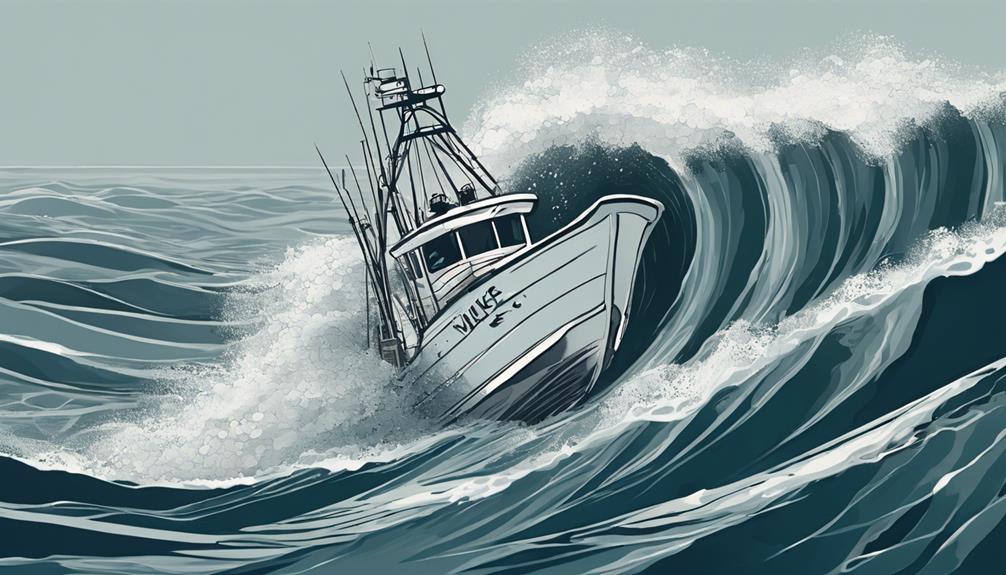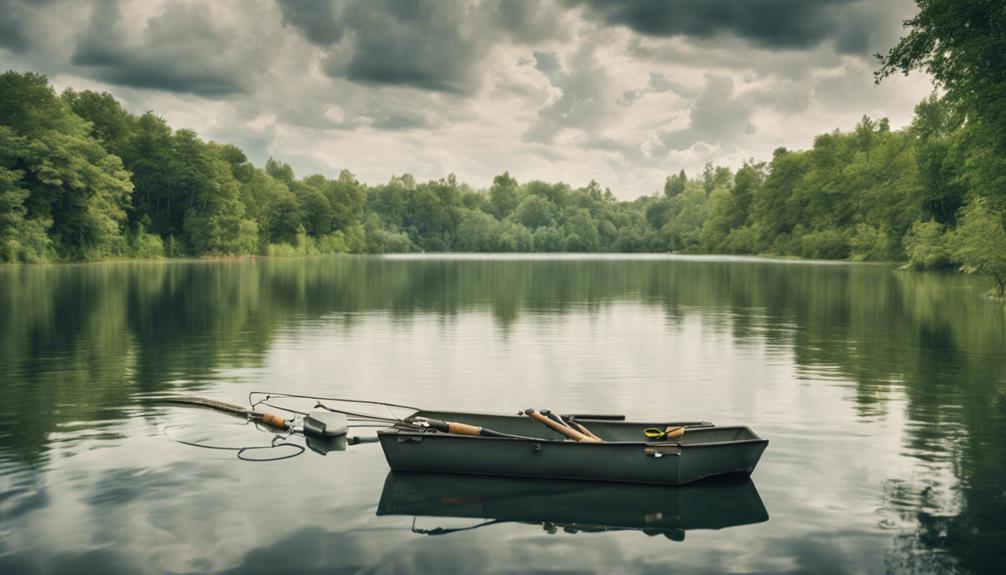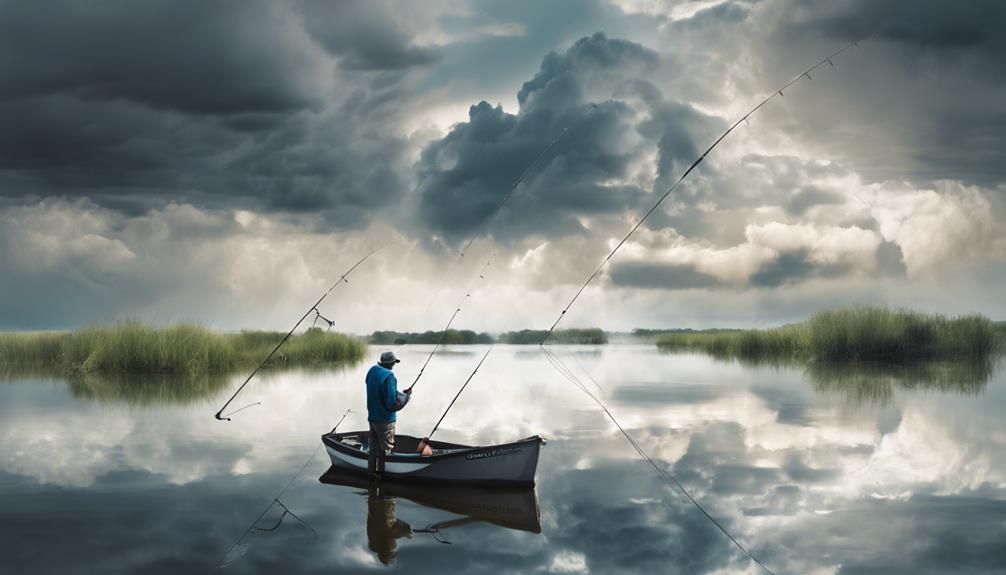When deciphering weather predictions for successful deep-sea fishing, it's crucial to comprehend the complex relationship between various weather patterns. Consider wind speed's influence on sea conditions and fish behavior, as well as the impact of barometric pressure fluctuations on fish activity levels. Analyze how cloud cover and temperature changes affect fish distribution and catch rates. Understand tidal influences on ocean currents and fish populations. Interpret wave height to gauge ocean energy levels accurately. Utilize reliable weather apps for real-time alerts and detailed forecasts to optimize your deep-sea fishing strategies. Mastering these weather intricacies can greatly enhance your fishing success.
Importance of Weather Patterns
Understanding weather patterns is crucial for deep-sea fishing success. Weather patterns analysis is a key component in developing effective fishing success strategies. By analyzing weather patterns, you can anticipate changes in conditions that may affect fish behavior and feeding patterns. This analytical approach allows you to plan your fishing trips more effectively, increasing your chances of a successful catch.
One important aspect of weather patterns analysis is studying pressure systems. Low-pressure systems often bring stormy weather and rough seas, which can make fishing challenging. On the other hand, high-pressure systems typically bring calm seas and stable conditions, providing ideal fishing opportunities. By monitoring pressure systems, you can choose the best times to head out for a deep-sea fishing excursion.
Another crucial factor to consider is the influence of temperature changes on fish movements. Fish are cold-blooded creatures, meaning their activity levels are affected by water temperature. By tracking temperature fluctuations, you can predict where fish are likely to be located at different times of the day. This knowledge allows you to adjust your fishing strategies accordingly, increasing your chances of a successful catch.
Understanding Wind Speed
Analyzing wind speed is integral to your deep-sea fishing success as it directly impacts sea conditions and fish behavior. Wind speed, in conjunction with wind direction, plays a crucial role in determining the surface movement of the water, which subsequently influences where fish are likely to gather. Understanding wind speed is vital for tailoring your fishing strategy to maximize your catch.
Wind direction is a key factor to consider when assessing wind speed. Winds blowing onshore can cause rougher seas near the coast, potentially pushing fish to deeper waters. Conversely, offshore winds typically create calmer seas closer to shore, which can concentrate fish in these areas. By monitoring wind direction alongside wind speed, you can better predict where fish are likely to be located.
When it comes to adjusting your fishing strategy based on wind speed, remember that higher wind speeds often result in choppier waters, making it more challenging to maintain control of your boat and fishing gear. In such conditions, focusing on drift fishing techniques may be more effective than anchoring. Additionally, higher wind speeds can lead to increased wave action, which might impact fish behavior. Fish are sensitive to changes in their environment, so being aware of how wind speed influences sea conditions is crucial in optimizing your deep-sea fishing experience.
Impact of Barometric Pressure
Barometric pressure significantly influences deep-sea fishing conditions, impacting fish behavior and your overall fishing success. Barometric fluctuations, which are changes in atmospheric pressure, play a crucial role in determining fish activity levels. Fish are sensitive to these fluctuations and often exhibit different behaviors in response to pressure changes. When the barometric pressure is high, fish tend to move deeper into the water, making them harder to catch. Conversely, during periods of low pressure, fish are more likely to move towards the surface, increasing catch rates.
Pressure systems, such as high-pressure systems and low-pressure systems, can have varying effects on fishing success. High-pressure systems are typically associated with clear skies and stable weather conditions. During these times, fish may be less active, leading to lower catch rates. On the other hand, low-pressure systems often bring cloud cover, precipitation, and choppy seas. Fish are more active in these conditions, making it an ideal time for fishing.
To optimize your deep-sea fishing trips, it's essential to monitor barometric pressure trends. By paying attention to pressure fluctuations and understanding how they influence fish behavior, you can increase your chances of a successful fishing outing. Remember, being aware of these atmospheric changes can make a significant difference in your overall fishing experience.
Significance of Cloud Cover
Cloud cover plays a crucial role in deep-sea fishing conditions, affecting fish behavior and catch rates significantly. When considering cloud formations, it's essential to understand their impact on fishing success. Cloud cover can influence light penetration into the water column, affecting the depth at which fish may be feeding. In general, overcast skies can lead to increased fishing activity as fish may feel more secure and venture closer to the surface. Conversely, clear skies with minimal cloud cover may push fish to deeper waters, making them harder to locate and catch.
In terms of fishing strategy, anglers should adapt their techniques based on the prevailing cloud cover. On bright, sunny days with little cloud cover, using deeper diving lures or baits and targeting deeper water can improve the chances of a successful catch. In contrast, on cloudy days, surface lures or baits may be more effective as fish are likely to be more active near the top layers of the water. Additionally, adjusting the speed and retrieval patterns of lures to match the light conditions influenced by cloud cover can also enhance fishing success.
Understanding the relationship between cloud cover and fishing conditions is crucial for deep-sea anglers looking to optimize their catch rates. By incorporating cloud cover analysis into their fishing strategy, anglers can adapt to changing conditions and increase their chances of a fruitful fishing expedition.
Effect of Temperature Changes
Temperature fluctuations in the deep-sea environment play a critical role in influencing the behavior and distribution of marine species, impacting the success of fishing expeditions. Temperature changes affect the metabolic rates, reproductive cycles, and migration patterns of fish. When the water temperature shifts, it can lead to fish moving to different depths or locations in search of their preferred thermal conditions. Some species may become more active in warmer waters, while others might slow down. This fluctuation influences the availability of target species for fishing.
Understanding temperature changes is crucial for deep-sea fishermen. Warmer waters can attract certain species closer to the surface, making them more accessible for fishing. Conversely, colder temperatures may drive fish to deeper waters, requiring adjustments in fishing techniques and equipment. Monitoring temperature gradients can help predict where fish are likely to be found, increasing the chances of a successful catch.
Moreover, temperature changes impact the abundance and distribution of plankton and other prey species, which in turn affects the distribution of larger fish. Fishing success is closely tied to the ability to adapt to these temperature fluctuations and anticipate how they influence the behavior of target species. By staying informed about temperature trends and their effects on marine life, fishermen can enhance their deep-sea fishing outcomes.
Role of Ocean Currents
Ocean currents play a significant role in shaping the movement patterns of marine species and influencing the distribution of fish populations in deep-sea fishing environments. Understanding current behavior and tidal influences is crucial for successful deep-sea fishing. Here are three key points to consider:
- Current Behavior: The behavior of ocean currents dictates the direction and speed at which marine species move. Fish often follow these currents, using them as highways to navigate the vast ocean expanses. By studying the behavior of currents, anglers can predict where fish are likely to be present, increasing the chances of a successful catch.
- Tidal Influences: Tides play a crucial role in determining the strength and direction of ocean currents. The gravitational pull of the moon and the sun causes tides to ebb and flow, influencing the movement of water masses. Anglers need to be aware of how tides affect currents in their fishing areas to optimize their fishing strategies.
- Distribution of Fish Populations: Ocean currents act as natural barriers and facilitators for the distribution of fish populations. Certain species prefer specific temperature ranges and water conditions, which are often created by the interaction of currents. By understanding these patterns, fishermen can target their desired species more effectively.
Interpreting Wave Height

Understanding how to interpret wave height is crucial for deep-sea fishermen to assess the conditions of the open waters accurately. Wave height is a key indicator of the energy present in the ocean, influenced by factors such as wind speed, duration, and fetch. When interpreting swells, focus on both the wave height and the distance between each wave to gauge wave consistency. Consistent swells often indicate stable weather conditions, while irregular swells may suggest changing weather patterns.
Forecast accuracy plays a significant role in predicting wave height. Meteorological agencies utilize advanced models to forecast wave conditions, considering variables like wind patterns and atmospheric pressure. These forecasts provide valuable insights for fishermen planning deep-sea excursions. Understanding the source of the wave height prediction can enhance your ability to make informed decisions about venturing into the open sea.
When preparing for a deep-sea fishing trip, pay close attention to the predicted wave heights. Comparing forecasts from multiple reliable sources can help you gain a more comprehensive understanding of the expected wave conditions. By combining this information with your knowledge of interpreting wave height, you can make informed choices that maximize safety and increase the likelihood of a successful fishing expedition.
Utilizing Weather Apps
When planning your deep-sea fishing trips, leveraging weather apps can provide crucial real-time data for assessing current and future weather conditions. These apps offer a range of features that can significantly enhance your fishing experience. Here are three key ways weather apps can benefit your deep-sea fishing adventures:
- Real-Time Weather Alerts:
Weather apps deliver up-to-the-minute alerts on changing weather patterns, including approaching storms or sudden shifts in wind direction. By staying informed through these alerts, you can make timely decisions to ensure your safety and the success of your fishing trip.
- Hourly Forecast Updates:
Weather apps provide detailed hourly forecasts, giving you insights into temperature changes, cloud cover, precipitation, and wind speed. This information is invaluable for planning your fishing strategies throughout the day, such as determining the best times for deep drops or surface fishing.
- Customizable Notifications:
Many weather apps allow you to customize notifications based on your specific preferences. You can set alerts for conditions like ideal fishing temperatures, low wind speeds, or specific fish behavior patterns. These tailored notifications can help you optimize your fishing tactics and maximize your catch rates.
Frequently Asked Questions
How Can Lunar Phases Affect Deep-Sea Fishing Success?
When considering how lunar phases impact deep-sea fishing success, it's essential to focus on fish activity. Lunar cycles play a significant role in regulating fish behavior. Different moon phases can influence feeding patterns, spawning activities, and overall movement of fish in the water.
Anglers should pay attention to lunar calendars to plan their fishing trips effectively, as certain lunar phases can lead to increased fish activity and better chances of a successful catch.
Are There Specific Weather Patterns That Attract More Fish?
Certain weather patterns can indeed attract more fish. Temperature fluctuations play a crucial role in fish behavior, affecting their feeding habits.
Additionally, wind direction can influence where fish gather to feed. Understanding these factors can help you identify optimal fishing conditions.
Can Underwater Topography Influence Fishing Conditions?
Underwater topography can significantly influence fishing conditions. Currents impact the movement of fish populations, directing them to certain areas with favorable conditions.
Temperature variations caused by underwater features can create ideal environments for different types of marine life, affecting their distribution and behavior.
Understanding the interplay between underwater topography and fishing conditions is crucial for successful deep-sea fishing expeditions. Paying attention to these factors can lead to more productive and rewarding fishing trips.
What Role Do Air Pressure Systems Play in Fishing?
Air pressure dynamics are crucial in fishing. Weather systems impact angler strategies significantly. Understanding how air pressure systems influence water conditions can enhance your fishing techniques.
Low-pressure systems often signify stormy weather, leading to more active fish feeding near the surface. High-pressure systems typically bring calmer seas and may require adjusting lure depths. Monitoring air pressure changes can help you anticipate fish behavior and optimize your chances of a successful catch.
Do Different Fish Species React Differently to Weather Conditions?
Different fish species exhibit varying responses to weather conditions. Fish behavior is influenced by factors like temperature, sunlight, and air pressure. Weather impact can lead to changes in fish activity levels, feeding patterns, and migration routes.
Understanding these nuances is crucial for successful fishing trips. By considering how different species react to weather conditions, anglers can adjust their strategies to maximize their chances of a productive catch.
Conclusion
In conclusion, deciphering weather predictions is crucial for successful deep-sea fishing. By understanding wind speed, barometric pressure, cloud cover, temperature changes, ocean currents, and wave height, fishermen can make informed decisions on when and where to fish.
Utilizing weather apps can provide real-time data that can greatly enhance fishing trips. By paying attention to these weather patterns, fishermen can increase their chances of a fruitful and safe deep-sea fishing experience.



